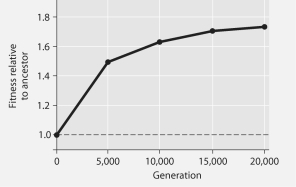The following questions refer to Figure 27.1 below, which is the same as Figure 27.10 in the textbook.
In this 8-year experiment, 12 populations of E. coli, each begun from a single cell, were grown in low-glucose conditions for 20,000 generations. Each culture was introduced to fresh growth medium every 24 hours. Occasionally, samples were removed from the populations, and their fitness in low-glucose conditions was tested against that of members sampled from the ancestral (common ancestor) E. coli population.

Figure 27.1
-E. coli cells typically make most of their ATP by metabolizing glucose. Under the conditions of this experiment, what should be True of E. coli's generation time (especially early in the course of the experiment, but less so later on) ?
A) Generation time should be the same as in the typical environment.
B) Generation time should be faster than in the typical environment.
C) Generation time should be slower than in the typical environment.
D) It is theoretically impossible to make any predictions about generation time, under these conditions.
Correct Answer:
Verified
Q8: Which of the following is an important
Q21: Which of the following traits do archaeans
Q29: If archaeans are more closely related to
Q33: The following questions refer to Figure 27.1
Q34: Figure 27.2 depicts changes to the amount
Q35: Match the numbered terms to the descriptions
Q36: The following questions refer to Figure 27.1
Q37: Figure 27.2 depicts changes to the amount
Q42: Which of the following use light energy
Q46: During which two times can the recipient
Unlock this Answer For Free Now!
View this answer and more for free by performing one of the following actions

Scan the QR code to install the App and get 2 free unlocks

Unlock quizzes for free by uploading documents